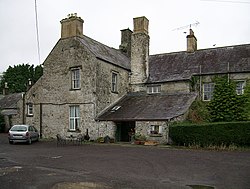Durhamstown | |
|---|---|
Townland | |
 Buildings on the Durhamstown Castle estate | |
| Coordinates: 53°39′N6°47′W / 53.650°N 6.783°W | |
| Country | Ireland |
| Province | Leinster |
| County | County Meath |
| Civil parish | Ardbraccan |
| Area | |
• Total | 4.15 km2 (1.60 sq mi) |
| Population (2011) [2] | 319 |
| Time zone | UTC+0 (WET) |
| • Summer (DST) | UTC-1 (IST (WEST)) |
| Irish Grid Reference | N808684 |
Durhamstown (Irish : Baile an Dormhamaigh),[ citation needed ] known less frequently as Dormstown, is a townland outside Navan in County Meath, Ireland. In religious terms it is covered by the Roman Catholic parish of Bohermeen. Durhamstown townland lies in the civil parish of Ardbraccan, and has an area of 1,025 acres (1.602 sq mi). [1] [3]
